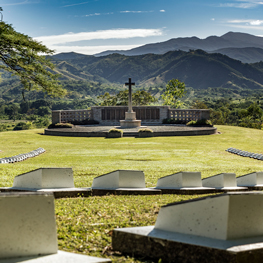Constructed in 1870, the building that today houses the Bourail Museum and Tourist Information Office was originally the prison service store. Nowadays, each year, several thousand visitors flock here for a journey back in time or to view the last guillotine used in New Caledonia!
Since 1910 and the days of the penitentiary, the building has taken on varying roles, accommodating a transport company, a cheese shop, and veterinary services, before being listed as a historic monument in 1980. The Bourail town hall assumed its ownership and, in 1986, it was turned into a museum, driven by the passions of history enthusiasts who chose to exhibit there a variety of period items of domestic life gathered from private collections.
Un monument historique
Voir plus-
![Une région au caractère agricole]()
The agricultural character of the region
On the first floor are a set of fifteen display cases with a historic theme. Some portray tribal life before the implantation of the penal colony, the arrival of the first convicts in 1867 and their installation as concessionaries; others illustrate the presence of close to 2,000 Arab deportees in Bourail, mostly from Algeria. The exhibit also gives a broad look at the agricultural character of the region, including coffee growing with its epic story and also the cotton plantations. Another display case illustrates a more familiar theme, reminding us of New Zealand’s presence in the region during WWII.
-
![La case de chef Kanak]()
The kanak case
On the ground floor and in the annexes, there are model replicas of a house, a forge, a bakery, and a dairy, giving visitors a glimpse of rural life at the turn of the 20th century. Exhibited in a case unfortunately badly damaged by Cyclone Erica, in 2003, is a remarkable prehistoric rock carving found at Nessadiou.
-
![A weaving workshop]()
A weaving workshop
In addition to the tour of the museum itself, the visitors are also invited, on Tuesday mornings between 9 am and 12 noon, to follow a weaving workshop where “pupils” learn the basic technique (maybe more!) of braiding the leaves of the pandan tree. In ancient times, this braiding activity was primarily a pastime practiced by most tribal women. The braids were most frequently used for making yam harvesting bags. Even today, there are some women who maintain this ancient tradition and are dedicated to passing it on to students, passing tourists or inhabitants of the region of Bourail. A few sessions are enough to finish a small bag, crown or hair decoration. The rolls of yams and raffia are just waiting there for you!








